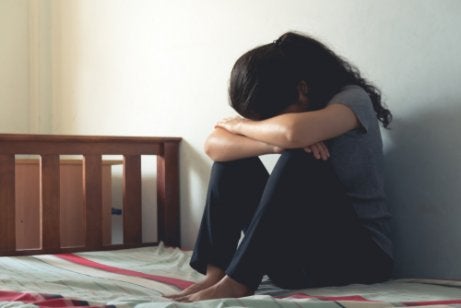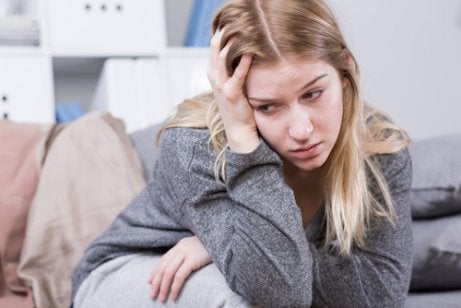Postpartum Psychosis: Description, Prevention, and Treatment

Becoming a mother is a life transition that involves significant changes in every aspect of a woman’s life. Pregnancy and birth trigger hormonal, physiological, cognitive, and social changes that women have to adapt to if they want to stay sane and healthy. However, this process can become complicated by disorders and conditions such as postpartum psychosis.
For many years, medicine and science generally held up the idea that motherhood was good for women’s mental health. In addition, medical professionals tended to ignore any psychopathological symptoms in pregnant and postpartum women. They treated them as normal side-effects of the process and believed that they always went away on their own.
While the importance of perinatal mental health care is an idea that’s gaining traction, there still aren’t specific diagnoses or treatments designed to address these issues.
In spite of the fact that the prevalence of perinatal mental disorders is high, approximately 25%, women still aren’t getting the care they need. Doctors often just prescribe anti-depressants and send women on their way even when they do try to discuss their concerns.
You can’t attribute the lack of attention and options for treatment to the novelty of the condition, since the relationship between the postpartum period and mood changes, especially psychosis, dates back to Hippocrates (700 BC). In the 18th and 19th centuries, French and German medical literature introduced the first systematic studies of postpartum psychosis.
The term postpartum psychosis was coined by Furstner in 1875 and refers to the most serious of the category of disorders that happen soon after birth.

What are the symptoms of postpartum psychosis?
Postpartum psychosis consists of psychotic episodes, usually manic, but also depressive or mixed that start a few days after giving birth (two weeks postpartum), though they aren’t necessarily emotional or psychotic episodes at first. Manic symptoms tend to be logorrhea, racing thoughts, overactivity, and euphoria.
The onset of postpartum psychosis is usually a sudden psychotic episode that occurs hours or days after giving birth. There’s minimal lead-up, which makes prevention difficult. The symptoms are based on elation and depression with intense mood swings. It’s also common for patients to appear confused and perplexed, similar to what happens with organic psychosis. Occasionally, women with postpartum psychosis suddenly aren’t aware of either giving birth or being pregnant.
It’s important to note that the first three weeks postpartum is the time period with the highest risk. Nevertheless, symptoms usually appear within hours or three days of giving birth. Postpartum psychosis doesn’t last long. Individuals experiencing psychosis return to their previous state fairly quickly and the symptoms disappear.
Hallucinations and delusions can occur, although there isn’t a lot of information about them. They usually have something to do with the newborn baby. Hallucinations can be visual, tactile, or olfactory.
Causes of postpartum psychosis
This condition is related to changes in the brain that happen during birth. Some risk factors may predispose some women to psychosis, such as past psychiatric issues, being a first-time mom, obstetric complications such as infections, preeclampsia, and sleep deprivation, and a family history of bipolar disorder.
In their 2001 study, authors Jones and Craddock showed that postpartum psychosis has a clear genetic component. They also found that bipolar disorder seems to run in families. However, they haven’t been able to identify a specific gene.
Another hypothesis is that psychosis is due to neurohormonal vunerability. During pregnancy, women are exposed to high levels of estrogen, which decreases activity of the hydrodsilax tyrosine enzyme involved in dopamine synthesis.
Reduced dopamine levels lead to hypersensitive dopamine D2 receptors and, then, the consequent rise in dopamine after giving birth. The increase in dopamine in the brain is responsible for the psychotic symptoms. Consequently, researchers are looking at the possibility of prophylactic estrogen treatment to prevent postpartum psychosis.
Another theory is related to the immune system. During pregnancy, a woman’s immune system turns itself down a few notches in order to facilitate tissue compatibility with the fetus. After birth, however, the immune system kicks into high gear again and sometimes goes a little haywire, which is why postpartum women have a higher risk of developing an autoimmune disorder.

Treatment
The standard treatment for postpartum psychosis involves a hospital stay for both mother and baby. It’s the best way to prevent potentially tragic consequences, such as suicide or filicide. The hospital staff encourages mother-child bonding and avoids separating them unless absolutely necessary.
In terms of medications, doctors usually prescribe high doses of mood stabilizers and antipsychotics (also known as neuroleptics). Also, they occasionally use electroconvulsive therapy (ECT), which poses no risk to the unborn child. If there’s a possibility of using it before the birth, it’s important to analyze the cost/benefit analysis for the last trimester of pregnancy or immediately after birth.
Also, a kind of therapy seems to be effective. It’s called video-feedback therapy and doctors use it for women with emotional or psychotic disorders. The therapy helps them increase sensitivity towards their babies and reduce passivity. In short, it encourages cooperative behavior. Getting the mother to get into the maternal role is essential for recovery.
Becoming a mother is a life transition that involves significant changes in every aspect of a woman’s life. Pregnancy and birth trigger hormonal, physiological, cognitive, and social changes that women have to adapt to if they want to stay sane and healthy. However, this process can become complicated by disorders and conditions such as postpartum psychosis.
For many years, medicine and science generally held up the idea that motherhood was good for women’s mental health. In addition, medical professionals tended to ignore any psychopathological symptoms in pregnant and postpartum women. They treated them as normal side-effects of the process and believed that they always went away on their own.
While the importance of perinatal mental health care is an idea that’s gaining traction, there still aren’t specific diagnoses or treatments designed to address these issues.
In spite of the fact that the prevalence of perinatal mental disorders is high, approximately 25%, women still aren’t getting the care they need. Doctors often just prescribe anti-depressants and send women on their way even when they do try to discuss their concerns.
You can’t attribute the lack of attention and options for treatment to the novelty of the condition, since the relationship between the postpartum period and mood changes, especially psychosis, dates back to Hippocrates (700 BC). In the 18th and 19th centuries, French and German medical literature introduced the first systematic studies of postpartum psychosis.
The term postpartum psychosis was coined by Furstner in 1875 and refers to the most serious of the category of disorders that happen soon after birth.

What are the symptoms of postpartum psychosis?
Postpartum psychosis consists of psychotic episodes, usually manic, but also depressive or mixed that start a few days after giving birth (two weeks postpartum), though they aren’t necessarily emotional or psychotic episodes at first. Manic symptoms tend to be logorrhea, racing thoughts, overactivity, and euphoria.
The onset of postpartum psychosis is usually a sudden psychotic episode that occurs hours or days after giving birth. There’s minimal lead-up, which makes prevention difficult. The symptoms are based on elation and depression with intense mood swings. It’s also common for patients to appear confused and perplexed, similar to what happens with organic psychosis. Occasionally, women with postpartum psychosis suddenly aren’t aware of either giving birth or being pregnant.
It’s important to note that the first three weeks postpartum is the time period with the highest risk. Nevertheless, symptoms usually appear within hours or three days of giving birth. Postpartum psychosis doesn’t last long. Individuals experiencing psychosis return to their previous state fairly quickly and the symptoms disappear.
Hallucinations and delusions can occur, although there isn’t a lot of information about them. They usually have something to do with the newborn baby. Hallucinations can be visual, tactile, or olfactory.
Causes of postpartum psychosis
This condition is related to changes in the brain that happen during birth. Some risk factors may predispose some women to psychosis, such as past psychiatric issues, being a first-time mom, obstetric complications such as infections, preeclampsia, and sleep deprivation, and a family history of bipolar disorder.
In their 2001 study, authors Jones and Craddock showed that postpartum psychosis has a clear genetic component. They also found that bipolar disorder seems to run in families. However, they haven’t been able to identify a specific gene.
Another hypothesis is that psychosis is due to neurohormonal vunerability. During pregnancy, women are exposed to high levels of estrogen, which decreases activity of the hydrodsilax tyrosine enzyme involved in dopamine synthesis.
Reduced dopamine levels lead to hypersensitive dopamine D2 receptors and, then, the consequent rise in dopamine after giving birth. The increase in dopamine in the brain is responsible for the psychotic symptoms. Consequently, researchers are looking at the possibility of prophylactic estrogen treatment to prevent postpartum psychosis.
Another theory is related to the immune system. During pregnancy, a woman’s immune system turns itself down a few notches in order to facilitate tissue compatibility with the fetus. After birth, however, the immune system kicks into high gear again and sometimes goes a little haywire, which is why postpartum women have a higher risk of developing an autoimmune disorder.

Treatment
The standard treatment for postpartum psychosis involves a hospital stay for both mother and baby. It’s the best way to prevent potentially tragic consequences, such as suicide or filicide. The hospital staff encourages mother-child bonding and avoids separating them unless absolutely necessary.
In terms of medications, doctors usually prescribe high doses of mood stabilizers and antipsychotics (also known as neuroleptics). Also, they occasionally use electroconvulsive therapy (ECT), which poses no risk to the unborn child. If there’s a possibility of using it before the birth, it’s important to analyze the cost/benefit analysis for the last trimester of pregnancy or immediately after birth.
Also, a kind of therapy seems to be effective. It’s called video-feedback therapy and doctors use it for women with emotional or psychotic disorders. The therapy helps them increase sensitivity towards their babies and reduce passivity. In short, it encourages cooperative behavior. Getting the mother to get into the maternal role is essential for recovery.
All cited sources were thoroughly reviewed by our team to ensure their quality, reliability, currency, and validity. The bibliography of this article was considered reliable and of academic or scientific accuracy.
- Garcia-Esteve, Valdés, M., Manual de psiquiatría perinatal: guía para el manejo de los trastornos mentales durante el embarazo, posparto y lactancia. Editorial Panamericana (2016)
This text is provided for informational purposes only and does not replace consultation with a professional. If in doubt, consult your specialist.







